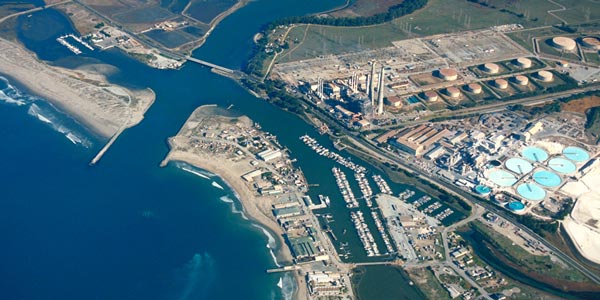By Jason Fordney
CAISO last week finalized its proposal for preventing the retirement of unprofitable power plants that may be needed for future system reliability, addressing concerns of some stakeholders about the initiative.
The ISO will discuss the draft final proposal for its Capacity Procurement Mechanism Risk-of-Retirement Enhancements (CPM ROR) initiative during a Sept. 20 call.

Pacific Gas & Electric’s Moss Landing Gas-Fired Power Plant
The grid operator altered the proposal to allow resources that currently have a resource adequacy (RA), CPM or ROR contract to apply for a CPM ROR designation — although they cannot have multiple designations at the same time. The revised plan also adjusts the deadlines for applying for CPM ROR designation and makes other changes for three different types of CPM ROR designations.
Generation owners Calpine, Pacific Gas and Electric and Southern California Edison raised questions about the plan after CAISO introduced the CPM Tariff provisions in May. The larger issue, many say, is that CAISO’s market increasingly produces negative prices from excess solar that leave generators unable to earn adequate revenue unless they have RA contacts. (See CAISO Stakeholders Question Risk-of-Retirement Initiative.)

Generation Owners Such as Calpine Express Concern Over CAISO Markets
Power sellers commenting on the straw proposal had urged changes to the program, which proposed to open two application windows each year — in April and November — for three types of risk-of-retirement designations. (See Power Sellers, LSEs Question CAISO ROR Designation.)
The latest draft provides additional detail about the reliability studies the ISO will perform to determine the need to designate generators as CPM ROR resources.
CAISO also altered the cost threshold requirement for obtaining a “Type 2” designation during the April window, rolling back a previous stipulation that a resource may not submit an ROR request for April unless its costs exceed the CPM soft offer cap. Type 2 refers to a request by an RA or a non-RA resource for designation in the calendar year following the current RA compliance year.
The updated proposal requires that a resource attest that it “reasonably believes” its annual fixed costs meet or exceed certain price thresholds.
“This requirement will help ensure that only resources that are less likely to receive an RA contract will be eligible for a Type 2 designation,” CAISO said. “This change provides an option for resources to use the April window and not have to wait until the November window to seek a designation.”
The ISO reasons that higher costs indicate that a generator likely will not be chosen as an RA resource. It said that it wants the CPM ROR payment to be based on cost of service and that the resource should be the only one that could meet an identified reliability need.
NRG Energy commented that the requirement would have meant that a resource with costs below the soft offer cap must wait until the November window. Forcing a generator to wait until November to seek a CPM ROR designation effectively negates one of the primary reasons why resource owners sought a change in the ROR process, the company contended.
The ISO also said it continues to support cost-of-service pricing to determine compensation. Most stakeholders also support that approach, although some changes were suggested.
Notable in the latest proposal is a provision that a CPM ROR designation no longer be voluntary but mandatory. Some stakeholders had wondered why CAISO would allow a resource not to accept a designation after being found necessary for reliability.
“The CAISO believes that [mandatory designation] is appropriate in circumstances where the resource has requested a CPM ROR designation, the CAISO has committed time and resources to conduct a reliability study, and the CAISO is determined that the resource is needed for reliability,” the ISO said. The grid operator said that approach is better than what some suggested — requiring a unit to shut down if it decides not to accept the designation.
The CAISO Board of Governors is due to review the CPM ROR proposal at its Nov. 1 meeting.



